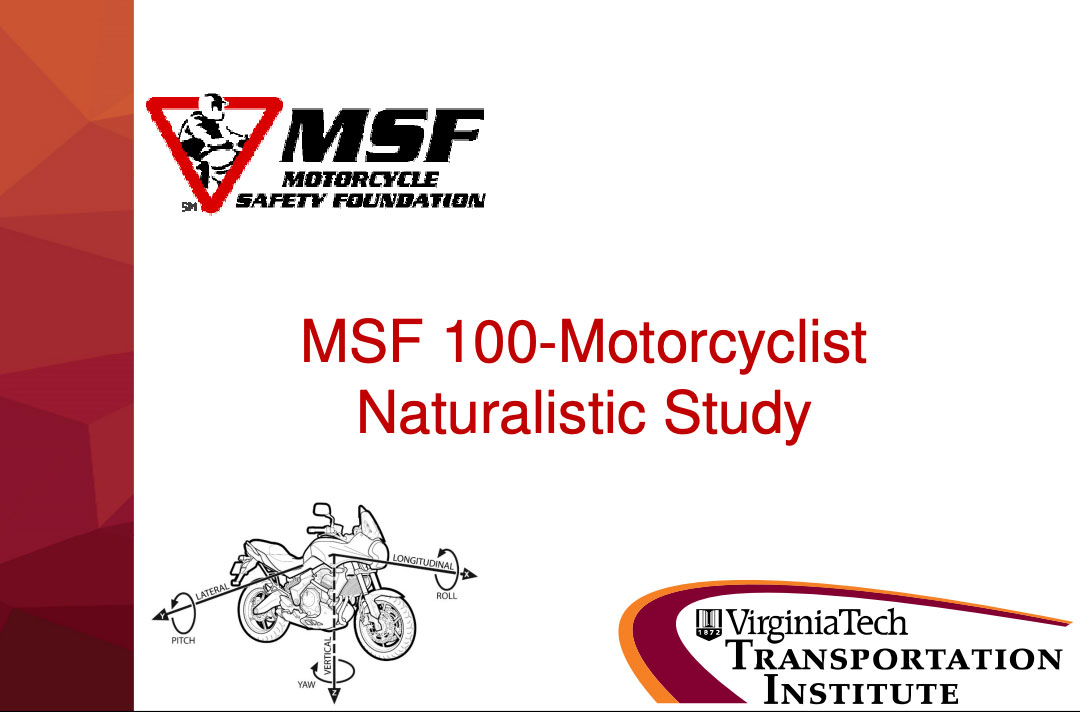In August 2011, The Motorcycle Safety Foundation and its member companies partnered with the Virginia Tech Transportation Institute to launch the world’s first, large-scale, naturalistic motorcycle riding study, the MSF100 Motorcyclists Naturalistic Study.
 During the 4-year study, data was collected from instruments installed on motorcycles owned by study participants as the bikes were ridden in normal day-to-day use. Sensors and video cameras recorded motorcycle operator inputs such as steering, acceleration, braking and lean, as well as recording motions of the motorcycle, current riding conditions and the actions of surrounding traffic. It was designed to track comprehensive, realtime routine riding that would likely include near crash, pre-crash, and actual crash data that had heretofore been unavailable. The motorcycle instrumentation was designed to be as inconspicuous as possible, so that participant-riders would forget their rides were being monitored.
During the 4-year study, data was collected from instruments installed on motorcycles owned by study participants as the bikes were ridden in normal day-to-day use. Sensors and video cameras recorded motorcycle operator inputs such as steering, acceleration, braking and lean, as well as recording motions of the motorcycle, current riding conditions and the actions of surrounding traffic. It was designed to track comprehensive, realtime routine riding that would likely include near crash, pre-crash, and actual crash data that had heretofore been unavailable. The motorcycle instrumentation was designed to be as inconspicuous as possible, so that participant-riders would forget their rides were being monitored.
A naturalistic traffic study differs from traditional research, where a participant is put into a specific, laboratory type scenario or has to crash first and then recall details after the fact. The naturalistic research methodology, observing drivers over extended periods in their own vehicles, had been found to be extremely valuable for studying known issues and revealing previously under-reported risk factors in automotive crashes. For example, data for the 100 Car Study (Dingus et al., 2006) were collected and analyzed in 2003-2004, and are still being used today by public and private entities. In 2008, NHTSA commissioned VTTI, the leader in this type of research, to investigate the feasibility of using the naturalistic methodology on motorcycles. VTTI tested camera, sensor, and data acquisition hardware to see if it was feasible to collect useful riding data over extended periods on participant motorcycles. The work provided the initial strategies that were later implemented in the MSF’s 100 Motorcyclists Naturalistic Study.
For the 100 Motorcyclists Naturalistic Study, MSF provided funding of $1,600,000, plus support for the study in the form of products and services, with a total value of roughly $2 million. VTTI supported the development of the data acquisition systems, hardware, and sensors, at an estimated cost of $600,000.
Three different locations were used to administer the study in order to provided a variety of riding and weather conditions, roadway environments, and traffic densities. In addition to VTTI’s headquarters in Blacksburg, Va., the other data collection facilities were the MSF headquarters in Irvine, Calif., and the Motorcycle Mechanics Institute in Orlando, Fla.
VTTI recruited 100 volunteer participants who owned one of seven motorcycle models representing the most popular categories of on-road motorcycles in use today: Suzuki GSX-R, Kawasaki Ninja, Honda Rebel, Yamaha V-Star, Harley-Davidson Sportster, Honda Gold Wing and Harley-Davidson Ultra Classic.
Approximately 38,581 trips were recorded. Combined, these trips totaled approximately 9,478 hours of riding, and a total of 363,000 miles. The study included frequent riders, who rode 145 days per year on average, and infrequent riders, who rode 30 days per year on average. Participant ages ranged from 21 to 80. 78% of the participant riders were male and 22% were female.
“We are very excited about this pioneering research,” said MSF President Tim Buche. “While we applaud the research that has been done in the past, we must acknowledge that, to date, we simply have had no data on how riders perform in everyday, uneventful riding. In the U.S. each year, riders travel over 25 billion miles, they ride safely and without incident. Riders have not been scientifically observed in a natural setting. And this naturalistic study is allowing us to learn from these riders and incorporate those findings into our rider education and training programs as well as other safety countermeasures.”
Several reports have been issued based on the data analyzed so far and can be viewed below; more in-depth reports will be published in the years to come.
Documents
Factors that Increase and Decrease Motorcyclist Crash Risk Presentation
Overview MSF 100 Study Presentation Oct17 Session2-McLaughlin-An Exploratory Analysis of Motorcyclist Apparel Using Naturalisti Riding Data PAPER5
MSF100 Motorcyclists Naturalistic Study – Preliminary Results 2013 (Paper)
MSF100 Motorcyclists Naturalistic Study – Exploring Human Factors 2014 (Presentation)
Motorcycle Research at VTTI MSF 100 Study Presentation
Exploratory Analysis of Motorcyclist Apparel Using Naturalistic Riding Data (Presentation)
Analysis of Mean Trip Speeds of Motorcycle Riders MSF 100 Study presentation Analysis of Mean
Trip Speed of Motorcycles Poster
Factors that Increase and Decrease Motorcyclist Crash Risk Study Paper


